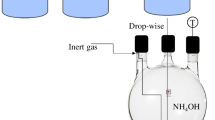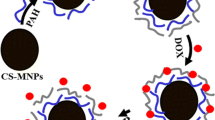Abstract
This work studied the effect of the application time of a non-permanent magnetic field on the rate of drug release from iron oxide polymeric nanoparticles. Magnetically responsive doxorubicin loaded poly(d-lactide-co-glycolide) (PLGA) nanoparticles were synthetized by the o/w solvent extraction/evaporation method and characterized. The produced particles show spherical shapes exhibiting a size between 200 and 400 nm, a drug loading of 3.6 % (w/w) and an iron concentration of 20.7 % (w/w). Cell cytotoxicity tests showed that unloaded magnetic PLGA nanoparticles were nontoxic. Concerning the therapeutic activity, doxorubicin-loaded magnetic particles cause a remarkable enhancement of the cell inhibition rates compared to their non-magnetic counterparts (40 against 7 % of dead cells). In vitro drug release studies performed under a non-permanent magnetic field show that the application time and the on/off cycle duration have a great influence with respect to the final amount and to the rate of drug release. The final amount and the rate of doxorubicin released increase with the time of field application reaching higher values for a higher number of pulses with a lower duration. Doxorubicin release mechanism has shown to be governed by Fickian diffusion in the absence of a magnetic field while in the presence of a magnetic field some controlled relaxation polymer chains might also be present. The results show that the drug release rate from magnetic PLGA nanoparticles can be modulated through the application time and the on/off cycles duration of a non-permanent magnetic field.









Similar content being viewed by others
References
Abdalla MO, Karna P, Sajja HK, Mao H, Yates C, Turner T, Aneja R (2011) Enhanced noscapine delivery using uPAR-targeted optical-MR imaging trackable nanoparticles for prostate cancer therapy. J Control Release 149:314–322
Alexiou C, Arnold W, Klein RJ, Parak FG, Hulin P, Bergemann C, Erhardt W, Wagenpfeil S, Lubbe AS (2000) Locoregional cancer treatment with magnetic drug targeting. Cancer Res 60:6641–6648
Alexiou C, Schmid RJ, Bergemann C, Henke J, Erhardt W, Huenges E, Parak FJ (2003) Magnetic drug targeting biodistribution of the magnetic carrier and the chemotherapeutic agent mitoxantrone after locoregional cancer treatment. J Drug Target 11:139–149
Andhariya N, Chudasama B, Mehta RV, Upadhyay RV (2011) Biodegradable thermoresponsive polymeric magnetic nanoparticles: a new drug delivery platform for doxorubicin. J Nanopart Res 13:1677–1688
Artemov D (2003) Molecular magnetic resonance imaging with targeted contrast agents. J Cell Biochem 90:518–524
Bicho A, Peça IN, Roque ACA, Cardoso MM (2010) Anti-CD8 conjugated nanoparticles to target mammalian cells expressing CD8. Int J Pharm 399:80–86
Cardoso MM, Peça IN, Roque ACA (2012) Antibody-conjugated nanoparticles for therapeutic applications. Curr Med Chem 19:3103–3127
da Silva EP, Sitta DLA, Fragal VH, Cellet TSP, Mauricio MR, Garcia FP, Nakamura CV, Guilherme MR, Rubira AF, Kunita MH (2014) Covalent TiO2/pectin microspheres with Fe3O4 nanoparticles for magnetic field-modulated drug delivery. Int J Biol Macromol 67:43–52
Demarchi CA, Debrassi A, Buzzi FC, Corrêa R, Filho VC, Rodrigues CA, Nedelko N, Demchenko P, Slawska-Waniewska A, Dłuzewski P, Greneche JM (2014) A magnetic nanogel based on O-carboxymethylchitosan for antitumor drug delivery: synthesis, characterization and in vitro drug release. Soft Matter 10:3441
Ditsch A, Lindenmann S, Laibinis PE, Wang DIC, Hatton TA (2005) High-gradient magnetic separation of magnetic nanoclusters. Ind Eng Chem Res 44:6824–6836
Fang C, Kievit FM, Veiseh O, Stephen ZR, Wang T, Lee D, Ellenbogen RG, Zhang M (2012) Fabrication of magnetic nanoparticles with controllable drug loading and release through a simple assembly approach. J Control Release 162:233–241
Gonzales M, Krishnan KM (2005) Synthesis of magnetoliposomes with monodisperse iron oxide nanocrystal cores for hyperthermia. J Magn Magn Mater 293:265–270
Guilherme MR, Oliveira RS, Mauricio MR, Cellet TSP, Pereira GM, Kunita MH, Muniz EC, Rubira AF (2012) Albumin release from a brain-resembling superabsorbent magnetic hydrogel based on starch. Soft Matter 8:6629–6637
Ito A, Tanaka K, Kondo K, Shinkai M, Honda H, Matsumoto K, Saida T, Kobayashi T (2003) Tumor regression by combined immunotherapy and hyperthermia using magnetic nanoparticles in an experimental subcutaneous murine melanoma. Cancer Sci 94:308–313
Jung CW (1995) Physical and chemical properties of superparamagnetic iron oxide MR contrast agents: ferumoxides, ferumoxtran, ferumoxsil. Magn Reson Imaging 13:661–674
Kocbek P, Kralj S, Kreft ME, Krist J (2013) Targeting intracellular compartments by magnetic polymeric nanoparticles. Eur J Pharm Sci 50:130–138
Lee S-J, Jeong J-R, Shin S-C, Kim J-C, Chang Y-H, Chang Y-M, Kim JD (2004) Nanoparticles of magnetic ferric oxides encapsulated with poly(D, L latide-co-glycolide) and their application to magnetic resonance imaging contrast agent. J Magn Magn Mater 272–276:2432–2433
Li M, Neoh K-G, Wang R, Zong B-Y, Tan JY, Kang E-T (2013) Methotrexate-conjugated and hyperbranched polyglycerol-grafted Fe3O4 magnetic nanoparticles for targeted anticancer effects. Eur J Pharm Sci 48:111–120
Minotti G, Menna P, Salvatorelli E, Cairo G, Gianni L (2004) Anthracyclines: molecular advances and pharmacologic developments in antitumor activity and cardiotoxicity. Pharmacol Rev 56:185–229
Monneret C (2001) Recent developments in the field of antitumor anthracyclines. Eur J Med Chem 36:483–493
Murakami H, Kobayashi M, Takeuchi H, Kawashima Y (2000) Further application of a modified spontaneous emulsification solvent diffusion method to various types of PLGA and PLA polymers for preparation of nanoparticles. Powder Technol 107:137–143
Na K, Lee ES, Bae YH (2003) Adriamycin loaded pullulan acetate/sulfonamide conjugate nanoparticles responding to tumor pH: pH dependant cell interaction, internalization and cytotoxicity. J Control Release 87:3–13
Papadimitriou S, Bikiaris D, Avgoustakis K, Karavas E, Georgarakis M (2008) Chitosan nanoparticles loaded with dorzolamide and pramipexole. Carbohydr Polym 73:44–54
Ritger PL, Peppas NA (1987) A simple equation for description of solute release II. Fickian and anomalous release from swellable devices. J Control Release 5:37–42
Roque ACA, Bispo S, Pinheiro ARN, Antunes JMA, Gonçalves D, Ferreira HA (2009) Antibody immobilization on magnetic particles. J Mol Recognit 22:77–82
Santos DP, Ruiz MA, Gallardo V, Zanoni MVB, Arias JL (2011) Multifunctional antitumor magnetite/chitosan-l-glutamic acid (core/shell) nanocomposites. J Nanopart Res 13:4311–4323
Seo SB, Yang J, Hyung W, Cho E-J, Lee T-I, Song YJ, Yoon H-G, Suh J-S, Huh Y-M, Haam S (2007) Novel multifunctional PHDCA/PEI nano-drug carriers for simultaneous magnetically targeted cancer therapy and diagnosis via magnetic resonance imaging. Nanotechnology 18:1–8
Tansik G, Yakar A, Gunduz U (2014) Tailoring magnetic PLGA nanoparticles suitable for doxorubicin delivery. J Nanopart Res 16:2171–2177
Wang J, Gong C, Wang Y, Wu G (2014) Magnetic nanoparticles with a pH-sheddable layer for antitumor drug delivery. Colloid Surf B 118:218–225
Yang J, Lee C-H, Park J, Seo S, Lim E-K, Song YJ, Suh J-S, Yoon H-G, Huh Y-M, Haam S (2007) Antibody conjugated magnetic PLGA nanoparticles for diagnosis and treatment of breast cancer. J Mater Chem 17:2695–2699
Acknowledgments
This work has been supported by Fundação para a Ciência e a Tecnologia, Portugal, through Grant No. PEst-C/EQB/LA0006/2013 and SFRH/BD/48773/2008 and contract PTDC/EQU-EPR/119631/2010. The authors would like to acknowledge Professor Ana Cecília Roque (REQUIMTE, FCT/UNL) for advice the synthesis of magnetic particles.
Author information
Authors and Affiliations
Corresponding author
Electronic supplementary material
Below is the link to the electronic supplementary material.
Rights and permissions
About this article
Cite this article
Peça, I.N., Bicho, A., Gardner, R. et al. Control of doxorubicin release from magnetic Poly(dl-lactide-co-glycolide) nanoparticles by application of a non-permanent magnetic field. J Nanopart Res 17, 427 (2015). https://doi.org/10.1007/s11051-015-3234-8
Received:
Accepted:
Published:
DOI: https://doi.org/10.1007/s11051-015-3234-8




